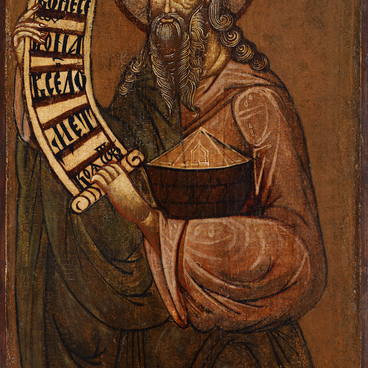Very little information remained about the founder of the Yugh Dorofey hermitage – Reverend Dorofey. It is known that he was born in the beginning or in the middle of the 16th century and took the vows in the Pskov-Pechersk Monastery. The Reverend was mentioned in several manuscripts including The legend of the miraculous icon of the Yugh Holy Mother and The description of the Yugh Dorofey cenobitic hermitage. These texts served as the foundation for the iconography of the Appearance of the Holy Mother to Reverend Dorofey.
According to the legend, after praying in the Pskov-Pechersk Monastery the monk Dorofey heard the voice of the Holy Mother. She commanded him to take the icon of The Holy Mother Hodegetria (Wayfinder) which she will point out from the monastery and take it to the Yaroslavl region. The icons of Holy Mother Hodegetria showed the Virgin Mary with baby Jesus in her hands. On the shore of the river Yugh not far from Rybinsk the monk put the icon of a tree and lied down to have some rest. When he woke up he could not take it off. At that moment he heard a voice saying: My icon and My godsend will remain here forever.
According to the legend, after praying in the Pskov-Pechersk Monastery the monk Dorofey heard the voice of the Holy Mother. She commanded him to take the icon of The Holy Mother Hodegetria (Wayfinder) which she will point out from the monastery and take it to the Yaroslavl region. The icons of Holy Mother Hodegetria showed the Virgin Mary with baby Jesus in her hands. On the shore of the river Yugh not far from Rybinsk the monk put the icon of a tree and lied down to have some rest. When he woke up he could not take it off. At that moment he heard a voice saying: My icon and My godsend will remain here forever.

